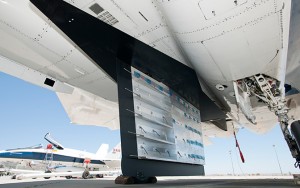Almost sixty-five years after Chuck Yeager broke the sound barrier, there’s still a lot we don’t know about supersonic aerodynamics, especially with transonic airflows. In designing supersonic aircraft, engineers often stick with what works in terms of airfoils and manufacturing specifications. With the development of stronger and lighter materials, however, it may be possible to create more innovative designs.
In order to test what might be possible, NASA’s Dryden Flight Research Center is conducting Supersonic Boundary Layer Transition (SBLT) tests in partnership with Aerion Corporation. Here’s the instrument pylon underneath a Dryden F-15B:
In an MIT course on Space Shuttle Systems Engineering, one of the designers of the Space Shuttle was asked why they chose to give the shuttle its huge delta wing. The response? Because the delta wing configuration was closely associated with top-line supersonic aircraft at the time (see the F-102 and F-106 for examples that the designers would have been familiar with during the design process). In other words, the configuration had been tested at high Mach speeds, seemed logical given the pressures involved, and they didn’t want to have to consider all possible airfoil designs, since testing would become prohibitively expensive.
Perhaps with continuing efforts to probe supersonic dynamics, though, we will be able to develop more efficient aircraft, and bring back the dream of supersonic airliners that got killed with the grounding of the Concorde. Aerion Corporation seeks to manufacture practical supersonic business jets, which is at least a start. Before we get airliners, we’ll have to deal with our fuel situation. If we don’t stop depleting our oil reserves, air travel may become too expensive for all but the wealthy – even under Mach 1 – before we get a chance to develop engine technology that can run on alternatives.

Informative article, just what I needed.
my web-site :: google